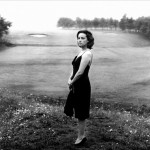Dir. by Michelangelo Antonioni
Images: Opening titles are cast on nearly abstract shots of skyscrapers, grounding the film immediately in the modern landscape. Actors are frequently framed on opposing sides of the screen, alienating them from one another. Crowds are noisy and hostile, forcing characters to retreat to isolation for solace. Favorite images: the shame and self-conscious look on Moreau’s face when she models her dress for Mastroianni; Moreau walking with a straight back in her wet black dress after the rain storm.
• • •
I’m very fond of Edward Hopper’s painting, New York Movie. It’s a great piece of early American modernism, simultaneously revealing, like a Fitzgerald novel, both the techniques of realism and the disillusionment and moral decay of the “lost generation.” Like many of Hopper’s portraits, “New York Movie” features a lone woman — here, a young usher — who suffers in isolation. Her pain is evident in her body language, her closed eyes and slumped shoulders, but, more importantly, it’s communicated by the composition of the painting itself. The woman leans against a side wall, framed in the lower right corner, while the majority of the portrait is devoted to the mass of the public watching a film in darkness. Hopper positions her under a wall sconce that draws our eyes instantly to her shadowed face.
A similar image occurs in the opening moments of Michelangelo Antonioni’s La Notte, when Lidia (Jeanne Moreau) stares out a hospital window, drawn there by the sound of a passing helicopter. Like Hopper, Antonioni composes the frame with his heroine in the lower right corner, alienating her completely from her surroundings. Despite the presence of her husband and her dying friend in the room, Lidia stands alone, here and throughout the remainder of the film.
La Notte has little plot to speak of. Antonioni follows Lidia and her husband, Giovanni (Marcello Mastroianni), through the course of one night, as they wander the streets of Milan, visit clubs, attend parties, and, finally, confront the cold apathy that has developed between them. Both rebuff the sexual advances of strangers, but they seem to do so only out of obligation or respectful loyalty. They are certainly both attracted to the strangers, if only for the temporary connection and passion that they might offer. Giovanni’s attraction to Valentina (Monica Vitti) is mostly physical — he stares at her like he does the black dancers who perform for him in a club — though he, the shrewd intellect, would surely deny the accusation. Lidia is drawn to Roberto (Giorgio Negro) because he simply offers her his attention and respect, neither of which have been available from her husband for years. In one of the film’s most touching scenes, Lidia and Roberto sit alone in a car as rain falls around them. Antonioni remains at a distance, letting them laugh and talk out of earshot. It’s the only time during the film that we see Moreau’s smile.
By examining in microscopic detail the workings of a marriage, that most essential of all human relationships, Antonioni extends his critique from the specific to the general, from the failings of a particular man and his particular wife to the apathy, solipsism, and alienation that plagues so much of the modern world. His is a world of towering mirrored skyscrapers, decaying brick alleyways, hostile, noisy crowds, and abrassive, intrusive technology, all of which send humanity fleeing to isolation for solace. With all that as its backdrop, the film’s finale plays like a grim satire of cinema’s cliched seduction scene. Lidia and Giovanni separate themselves from the crowd of party-goers (the Hopperesque framing returns once more) and make their way down a large empty field. They discuss their marriage in equal doses of bitterness, resignation, and denial, but finally admit that their love has atrophied. Giovanni’s response is interesting: he becomes emotional, but would probably be incapable of explaining why. Perhaps he is moved simply because Lidia’s confrontation has forced him to suddenly feel something, anything, for the first time in years. In what a less honest screenwriter would call a “fit of passion,” he lunges toward her to make love to her, while she whispers in his ear, “Tell me . . . Tell me.” That she wants to hear that he does not love her leaves the viewer with little hope for comfort.
My only criticism of La Notte is that too often Antonioni leaves us alone with his characters for extended periods, forcing us to listen to them talk and talk and talk about the human condition or other such matters of self-importance. I recognize the necessity of such scenes, as they reveal (intentionally or not) the emptiness of a purely intellectual existence. But they feel redundant to me. Antonioni’s camera, particularly when it’s directed on the faces of Moreau, Mastroianni, and Vitti, speaks more articulately than his flawed but sympathetic characters ever could.
